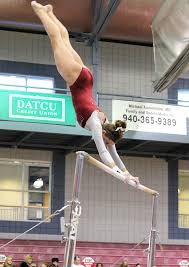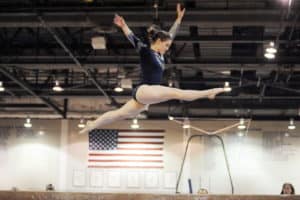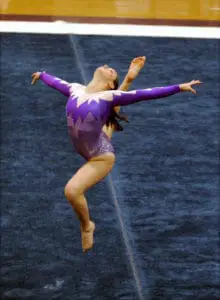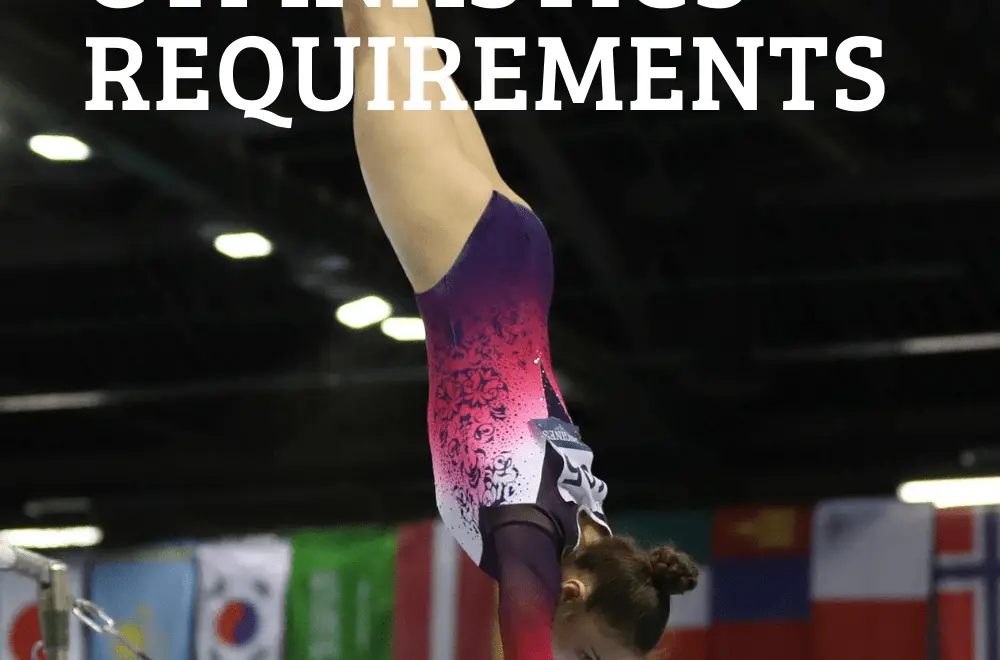Introduction to Xcel Platinum
This article has been updated to reflect the changes in the 2022-2026 Xcel Code of Points.
The fourth level, or division, as it’s called in Xcel gymnastics, is Xcel Platinum. The requirements in Xcel Platinum continue to progress from those in the Gold division. Gymnasts in the Xcel Platinum division typically have skills that are the equivalent of a DP Level 6.
Each division has its own set of skill and difficulty requirements. There are 4 Special Requirements on each event, except for vault. The requirements must be fulfilled by skills from the Xcel Code of Points, or from the division’s corresponding skills chart.
Let’s take a look at these requirements in the Platinum division.
Xcel Platinum Vault

At Xcel Platinum, the gymnast must perform vaults from the Xcel Platinum chart. All of these vaults are from the handspring family or twisting vaults without saltos. There is no more than 1 ½ total twist in any of the vaults, and no more than 1/1 twist in any phase. The vault list is almost the same as the Gold chart.
One difference is that a few of the vaults on the Platinum chart have a 9.7 or 9.9 SV.
The second difference is that Platinum gymnasts are allowed to perform roundoff-entry vaults (Yurchenkos). The roundoff-entry vaults they can perform are:
- RO, FF on, repulsion off
- RO, FF on, 1/2 twist off
Platinum gymnasts are still not allowed to perform flipping vaults.
The Platinum vaults that start at 9.7 include:
- Handspring
- ½ on
- Yamashita
- ¼ on, ¼ off – land facing away from the table
- RO, FF on, repulsion off
- RO, FF on, 1/2 twist off
The Platinum vaults that start at 9.9 include:
- Handspring, 1/2 off
- 1/2 on, 1/2 off
The rest of the vaults allowed in the Platinum division will start at a 10.0.
If a vault is performed that is not allowable for the division, it will receive a 0 (void vault).
Clarifications
Platinum gymnasts are not allowed to use the alternative springboard. If the alternative springboard is used, the vault will be VOID.
The execution deductions are the same in Platinum as they are in the Gold and Diamond divisions. Some of the major deductions that apply to these vaults include height (up to 0.50), distance (up to 0.30),angle of repulsion (up to 0.50) and too long in support (up to 0.50).
The vault is expected to be quick and dynamic, and to show a hip rise. The deductions listed above are there to separate vaults with good repulsion from vaults that do not have good repulsion. Focusing in these areas will help the gymnast to improve not only their Platinum vault, but their ability to progress to more difficult vaults in the future.
Xcel Platinum Bars

Value Parts
In the Platinum and Diamond divisions, gymnasts are required to perform skills with specific values in order to earn the maximum number of points. Skills, or Value Parts, in gymnastics are rated from A to E, with E being the most difficult. Platinum gymnasts must perform 6 A skills and 1 B skill in their routine. If the required Value Parts are not performed, a deduction is taken from the Start Value. A skills are worth 0.10, and B skills are worth 0.30.
Special Requirements
An Xcel Platinum bar routine has 4 Special Requirements. The requirements must be fulfilled by skills from the Xcel Code of Points, or by skills from the Xcel Platinum chart.
The Special Requirements are as follows:
- Kip
- A skill finishing in clear support above horizontal (not mount or dismount)
- 360° circling skill (not mount or dismount)
- Dismount from high bar
Difficulty Restrictions
Each division has difficulty restrictions specific to that division. This helps to level the playing field among gymnasts in that division.
Here are the difficulty restrictions for Xcel Platinum bars:
- No C or higher skills
There are three exceptions to this difficulty restriction. Xcel Platinum gymnasts MAY perform the following C skills, and they will receive B credit:
- Clear hip to handstand (no turn)
- Stalder to handstand (no turn)
- Sole circle to handstand (no turn)
Clarifications
Each Xcel division has certain rules that differentiate it from the USAG Development Program. Here are the clarifications for Xcel Platinum bars.
When will the “Skill Above Horizontal” requirement be awarded?
The Special Requirement for a skill above horizontal will be awarded to a skill that:
- Finishes in a clear support (hips away from the bar)
- Finishes within 10° of the angle requirement
This means that a skill finishing in clear support, at 9° below horizontal or higher, will receive Special Requirement credit. It will, however, receive a deduction of 0.10 for lack of amplitude if it is lower than 1° above horizontal.
No DP cast angle deductions
Casts in an Xcel Platinum bar routine are not subject to angle deductions like the DP program. Execution deductions apply, of course, but angle deductions do not. The only exception is that if the gymnast performs a cast within 10° of the requirement, the requirement will be awarded with a 0.10 amplitude deduction. This means that a Platinum gymnast can get Special Requirement credit for a cast that is 9° below horizontal, but a 0.10 deduction will be taken for the amplitude of the cast.
The angle of the cast is important in order to determine whether the cast receives Special Requirement and Value Part credit. The judges will evaluate casts and circling skills based on the angle from the shoulders to the lowest body part. For example, if the gymnast is arched, her cast is evaluated based on the angle from the shoulders to the belly.
Extra Swings
In the Platinum Division, gymnasts may perform one tap swing/counterswing for A Value Part credit. Any additional tap swings will receive a 0.30 extra swing deduction. Any extra casts, or “pumps” of the legs going into a cast, will also receive the 0.30 extra swing deduction.
Special Requirement Clarifications
At Xcel Platinum, there is no specific casting requirement. The gymnast does not need to perform a cast to a certain degree. She does need to perform one SKILL, though, which reaches above horizontal. That skill could be a cast, or it could be a circling skill that finishes in clear support. Examples of clear circling skills are clear hip circles, sole circles and stalders. The circling skill is allowed to reach handstand in Platinum, but if the gymnast performs a turn in handstand, it becomes a restricted skill.
If you choose to use a cast to meet the above horizontal requirement, be advised that if the gymnast falls short of the requirement, she will need 6 other A skills in her routine to receive her full Start Value.
A long hang pullover can meet the circling skill requirement, but ONLY if it comes from a cast.
There are no composition deductions in the Xcel program.
Side Note: Platinum gymnasts need to dismount from the high bar. Some gyms like for gymnasts to wear grips once they start swinging on the high bar. If you’re looking for a pair of grips, here is a guide to choosing grips for your gymnast.
Xcel Platinum Beam

Value Parts
The required Value Parts for beam are the same as bars: 6 A’s and 1 B. If the required Value Parts are not performed, a deduction is taken from the Start Value. A skills are worth 0.10, and B skills are worth 0.30. The gymnast may also perform C dance skills, which will count as B’s.
Special Requirements
Just like bars, an Xcel Platinum beam routine has 4 Special Requirements. The requirements must be fulfilled by skills from the Xcel Code of Points, or by skills from the Xcel Platinum chart. The gymnast may perform any A or B skills from the Xcel Code or the Platinum chart. C dance skills are also allowed.
- Minimum 1/1 turn on 1 foot
- Dance series to include two Group 2 skills, or leaps/jumps from Platinum chart (same or different) AND 1 leap/jump with min. 120° split (isolated or in series)
- One acro flight element OR an acro series (with or without flight, NOT mount/dismount)
- Dismount
Difficulty Restrictions
Here are the difficulty restrictions for an Xcel Platinum beam routine:
- No C acro skills
- No D or higher skills
Clarifications
Here are a few clarifications for Xcel Platinum beam.
First, all handstands are considered the same skill, regardless of the angle achieved. No hold is required to get credit for the handstand. The handstand must reach within 10° of vertical from the shoulders to the hips to get credit for a vertical skill. Handstands that are within 10° of vertical will receive credit with a 0.10 amplitude deduction.
Next, all acro skills must start and finish on the beam to receive credit. This includes skills that are part of an acro series.
If you have questions about the connection of an acro series, check out Is This Beam Series Connected?
There is no minimum time for a Platinum beam routine. There is no undertime deduction.
The split leap/jump angle requirement is 120° for Xcel Platinum beam routines. Credit is given for leaps/jumps that are within 20° of the division’s required split angle. This means that for Platinum leaps/jumps, they will receive credit if the split angle is 100° or higher.
All mounts are considered A’s unless they have a higher value in the Xcel Code of Points.
Xcel Platinum Floor

Special Requirements
An Xcel Platinum floor routine also has 4 Special Requirements. The requirements must be fulfilled by A or B skills from the Xcel Code of Points, or by skills from the Xcel Platinum chart. Xcel Platinum gymnasts may also perform C dance skills on floor.
- 1st acro pass: 2 directly connected acro flight skills with an A or B salto
- 2nd acro pass: Either (a) 2nd pass with 2 directly connected acro flight skills OR (b) One B salto
- Dance passage: 2 Group 1 elements, directly or indirectly connected, one of which is a leap with minimum 150° split
- Minimum 1/1 turn on 1 foot
Difficulty Restrictions
- No C acro skills
- No D or higher VP
Clarifications
All acro flight elements with hand support will receive credit, no matter how many times that element is performed, as long as the series is different. This is consistent through all of the Xcel divisions.
RO, Back Tuck and RO, BHS, Back Tuck are considered two different series and will count for Special Requirement credit.
A dive roll is not considered a flight element.
The split leap/jump angle requirement is 150° for Xcel Platinum floor routines. Leaps/jumps that are within 20° of the division’s required split angle will get their full value. This means that for Platinum leaps/jumps, they will receive credit if the split angle is 130° or higher.
There is no minimum time for Xcel floor routines. There is no undertime deduction.
Final Thoughts
This is a general overview of the requirements for the Xcel Platinum division. For more detailed information on each event, check out the articles below:
Xcel Vault: What You Need to Know
Xcel Bars: Bronze, Silver and Gold
Xcel Bars: Platinum and Diamond
References
USA Gymnastics Xcel Code of Points, 2022-2026.
